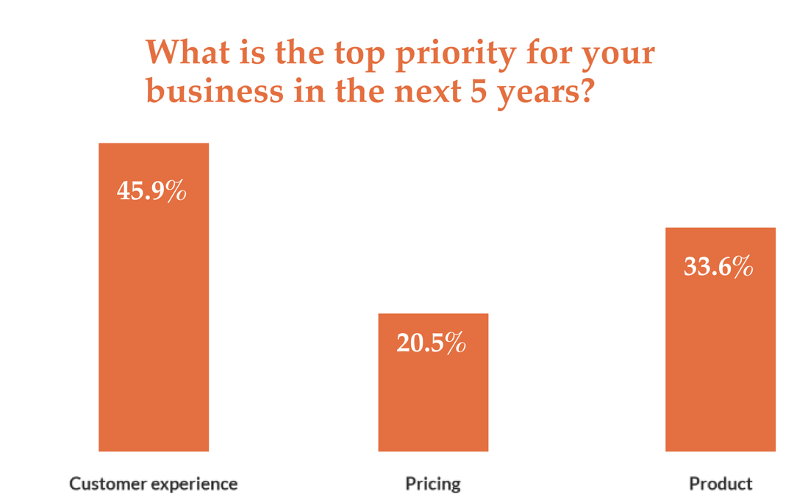Businesses are currently navigating a maze of myriad challenges. Global economic uncertainty, supply chain pains, and rising prices are causing organizations to rethink priorities.
Reflecting this new landscape, the frontline priority for businesses – ahead of pricing and products – is the customer experience (CX).
A recent SuperOffice survey found that the majority of business professionals have elevated CX to be their number one priority for the next 5 years
 Source: SuperOffice
Source: SuperOffice
The customer experience has been recognized as a key differentiator for businesses. Those that are investing in CX initiatives are able to deliver more seamless, impactful, and personalized digital journeys.
Content management systems have become important platforms to power engaging digital journeys, an influential part of the overall customer experience.
One of the leading content management systems is Adobe Experience Manager (AEM). It provides a range of features to create and deliver multi-channel personalized digital experiences. It powers big-name brands like Coca-Cola and Kellogg’s.
In fact, AEM is used by 110 Fortune 500 companies – roughly the same number of Argano clients that are Fortune 500 companies.
Argano works closely with a number of clients that use AEM to power their digital content, helping them develop and integrate solutions to their existing AEM platforms – whether it be AEM on-premise, AEM Managed Services, or AEM as a Cloud Service.
However, there is some breaking news for businesses that use AEM.
This is an attempt to put Adobe in a better position to roll out core enhancements, as it has control over all of its infrastructure-related items, while customers only need to deal with the customization of existing core components.
This means businesses that use AEM on-premise or AEM Managed Services are going to need to move – and that’s something Argano is helping its clients with.
We regularly carry out CMS migrations. They range from fairly simple projects that involve migrating from one platform to another to complex projects that involve replatforming a set of websites and touch points from one CMS to another.
One of the CMS platforms that Argano has deep experience with is AEM. Our clients include iconic sportswear brands, global social media platforms, and well-known camera manufacturers.
These brands benefit from our set of AEM services:
- Migration from AEM on-premise to Adobe Cloud
- Implementation of AEM add-ons
- Maintenance and customization of AEM as a Cloud Service
- Migration from AEM to another CMS platform
Migration from AEM on-premise to Adobe Cloud
Migrating to AEM as a Cloud Service is a big undertaking. It needs to be visualized as a comprehensive and complex project. Nothing less. We know because we’ve migrated many AEM on-premise platforms to Adobe Cloud. And we know the undertaking that is required.
The timeline of the migration is dependent on the size, complexity, and customizations of the platform as well as how it’s integrated into your business ecosystem and tools . So, let’s walk you through our seven-step approach.
Step one: assess the existing environment
We carry out a technical discovery process, which involves high-level tasks such as reviewing asset libraries, components and templates, existing functionalities and existing integrations.
Step two: create a migration plan
This outlines the process that is involved throughout the migration, including the timeline and the size of the team that is required.
Step three: set up the Adobe Cloud environment
We create all the necessary environments and configurations in the cloud to replicate the on-premise environment.
Step four: migrate content
This involves exporting the content from the existing environment and importing it into Adobe Cloud.
Step five: migrate customizations
If there are any customizations in the on-premise environment, we migrate them to Adobe Cloud. This may involve modifying code, configurations, or settings.
Step six: test
We go through a comprehensive, thorough testing phase to ensure that the migrated website is functioning correctly, and that all content and customizations have been migrated successfully.
Step seven: deployment
Once we’re done with the testing phase, we deploy the platform to the production environment in Adobe Cloud. It then moves to the UAT phase where the client can review everything before pushing it live.
Implementation of AEM add-ons
We plug AEM clients into the wider Adobe ecosystem by implementing solutions that cover personalization capabilities and customer journey analysis.
Leveraging the Adobe Target platform, we can integrate a broad range of solutions from AI-powered testing to automation functionalities. Whether you’re looking for greater testing capabilities or looking to elevate your brand’s omnichannel strategy, we work to find the best solution to move you forward.
For our customer journey analysis, we use Adobe Analytics to gain valuable insights to improve digital experiences. Our team will dig into the data from across the entire customer journey to analyze how they’re currently using the platform and recommend steps to improve the journey.
By extracting key insights from in-depth analysis, reporting, and predictive intelligence, we can put together a holistic view of current journeys before identifying the areas of improvement.
The benefits of Adobe Analytics include its AI and ML learning capabilities. It also excels with its faster streaming data, which makes data highly up to date, as well as its ability to collect data from emerging digital channels to provide a fuller picture of a company’s customers.
Maintenance and customization of AEM as a Cloud Service
For brands that are already on AEM as a Cloud Service, we provide maintenance and customization services.
Platform maintenance is the process of modifying software to correct errors, fix bugs, elevate performance and improve functionalities. It also involved updating core libraries and removing obsolete portions.
Our maintenance package involves identifying a growing concern among businesses: technical debt. This is the cost that a software project insures in the future by making short-term decisions to solve existing problems. It’s like opening a tab for software shortcuts – and when the time comes to pay up, it requires time and resources to get everything cleaned up.
We deploy our maintenance team to keep an eye on the client’s platform, ensuring that the user experience is kept both stable and reliable. We also carry out remediation planning and improvement planning to serve the goal of growing the platform.
Our approach looks something like this:
- Deploy the maintenance team
- Review backlog and technical debt
- Define an improvement plan based on a platform health check
- Incorporate or improve accessibility support
- Fix bugs
- Code refactoring and remove deprecated unused features
- Improve page speed across the website
- Recreate existing functionalities
- An optional step to carry out enhancements (from visual to functional ones)
Migration from AEM to another CMS platform
There are times when organizations migrate from one cloud solution to another. When clients are not satisfied with AEM to facilitate their business objectives, we help them migrate to another content management system.
We help clients do this in one of three ways: technical discovery, technical strategy, or the headless strategy.
Argano’s technical discovery involves deep diving into the business’s processes that follow a six-step analysis.
Step one: dissection. We dig into the details of how everything is currently working. We also review the platforms – not only from a user perspective but also from an administrative and maintenance perspective.
Step two: data mapping. Next, we identify where all the platforms’ data currently sits and how it’s being used. This ensures that we reduce the potential for errors involved in the migration. It also helps to visualize the data and find the best way to facilitate the migration.
Step three: operations and processes. The ultimate goal of having clean data is so that the end user achieves their objectives quickly and easily. That’s why we document each of the functions of the platform to ensure the new data models are able to serve all the current business needs.
Step four: migration and population. We map out the specific phases to get the new data models filled up with existing and new content. We will outline how they will be leveraged in a number of ways. For example, the processes for ongoing data scripts, the specifics for manual data management, etc.
Step five: data exposure. Once we have the data model in place, along with the content, we will outline how that will be consumed from the various platform components, such as page request consumption, API usage, data caching, security and more.
Step six: decision. Based on the previous steps, we determine which technical stack and architecture will be the best fit. We will also determine the new user experience flows as well as any other technical aspects under consideration.
From the foundations of the technical discovery, we map our technical strategy to the specific needs of the business, ensuring that we build the ideal architecture from the vision (and budget) of the business.
We determine the technical stack that is going to be required, the libraries needed, and any third-party services that are going to be used.
Then there is our headless strategy
There are many advantages of a headless strategy. It gives businesses the ability to have a fully responsive website. It provides you with a scalable ecosystem to adapt to changing business needs. It enables the creation of reusable content that can easily be positioned across multiple channels.
The Argano headless strategy is agnostic, meaning that we are not anchored to one platform. We choose the platform that fits the business’s vision; we don’t squeeze every brand into the same solution. Every platform has its advantages and fits better for some brands than others.
Whether it’s AEM, Contentful, Shopify or a customized solution, we access the needs and ambitions of the business before choosing the most appropriate platform.
When you go headless with Argano, we provide a stack of features that include:
- Fully designed user interface and user experience
- Modular development for website scalability and reusability
- Support for cross-platform browsers
- Support across multi-channel devices
- Google Analytics implementation
- A structured and easy-to-use content management platform
Are you looking to migrate to AEM Adobe Cloud? Are you already on the cloud but wanting greater personalization capabilities?
Then connect with us!






